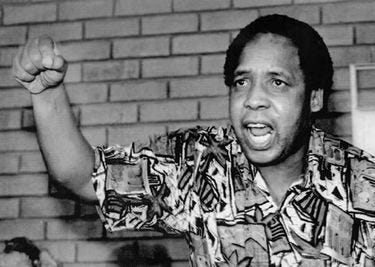Chris Hani. Part 1: The Altar Boy
Part one of who was Chris Hani, a South African freedom fighter whose murderer - Janusz Waluś - is now called "a hero" by the far-right
Why revisit Chris Hani now?
In late 2024, several popular Polish YouTube channels gave Janusz Waluś—a convicted assassin and far-right icon—a platform to distort South African history. This three-part series, originally published in Polish on LinkedIn, is a response.
This isn’t just about history. It’s about memory, myth—and what happens when the wrong people get to tell the story.
Before his death in 1993, Chris Hani was among the most prominent political figures in South Africa. His complicated life, multi-layered views and circumstances of death made him a South African icon. For the same reasons he became a symbol for the far-right that tried to show him as the man who might derail negotiations and ignite civil war. In different circles, both legends persist.
An Autumn day in South Africa
Chris Hani, a South African activist for the emancipation of the Black majority, was killed on April 10, 1993. He was assassinated in front of his home in a suburb of Boksburg, a medium-sized town near Johannesburg.
The shooter was Janusz Waluś, a Polish immigrant.
Hani became known as a leader of the South African Communist Party and commander of uMkhonto we Sizwe—the armed wing of the African National Congress (ANC). These two roles made him a target for the far-right, who built around him the myth of a communist warlord.
To understand how Chris Hani became a revolutionary, you have to start with the boy who wanted to be a priest.
Born in 1942, Chris Hani came from a background that was fairly typical for South Africa at the time. His father was a mineworker (and a political activist in the African National Congress, later exiled from the country), while his mother was illiterate.
He later recalled that he used to walk several kilometers to school each day, and once a week to church. Hani remembered being fascinated by the priests’ selflessness—the way they helped the local community. At the age of eight, he became an altar boy and, as a young boy, dreamed of joining the seminary.
His father stood in the way of this calling. But it was Catholicism that first planted in him a love of Latin and Greek, which he would later study.
Years later, when writing his brief autobiographical sketch—only a few pages long—he noted that the teachings of the Bible led him to believe that it was the African national Congress that truly carried out what Scripture promised.
And so, he gradually drifted away from the Church. He began to feel that the institution had little real interest in the fate of Black South Africans. He wrote:
“The dichotomy between the promise of a good life after death and the insufficient concern for the suffering of the present began to influence my thinking.”
The noose of apartheid
Born in 1942, Hani came of age just as the noose of apartheid was tightening.
When he was eight and beginning his service as an altar boy, the government introduced a new Immorality Act (a similar law had existed earlier)—a statute that made all extramarital sexual relations between whites and non-whites a criminal offense. Just before that, interracial marriages had been banned, and shortly afterward even foreign mixed marriages were outlawed.
The penalty for such “immoral behavior” between white and non-white persons could be up to eight years in prison.
When Hani was eleven, a new law cemented segregation in education. From then on, Black South Africans could attend only state-run schools (no longer, for instance, those run by Catholic missions).
These schools were designed to train obedient workers for the apartheid system. The logic behind this policy was evident in the parliamentary debate on the law, during which Hendrik Verwoerd, the then Minister of Native Affairs, argued:
“What is the use of teaching a Bantu child mathematics when he cannot use it in practice?”
At the age of fourteen, Hani witnessed the arrest of over 150 activists during an operation meant to intimidate opponents of the apartheid regime. The event entered history as the Treason Trial, a legal proceeding that lasted five years and in which Nelson Mandela was among the defendants. After five years, all of the accused were acquitted.
Hani finished his university education at a young age—he had skipped two grades in earlier years. At fifteen, he joined the youth wing of the African National Congress.
It was now 1960. The ANC’s official strategy still rejected armed resistance. Since 1912, its approach had been based on campaigns of nonviolent resistance, drawing on the example of Mahatma Gandhi, who had begun his activism in South Africa.
But that vision changed after the Sharpeville Massacre. On March 28, 1960, in the township of Sharpeville—about 70 kilometers south of Johannesburg, home to laborers for nearby industrial centers—a protest took place.
The demonstrators were expressing their opposition to pass laws, which restricted the movement of Black South Africans. The police (who later claimed they acted out of fear) opened fire. For forty seconds, the forces of the apartheid government fired into the crowd. Ian Berry, a British photographer on the scene, at first believed the police were using blanks. He was wrong.
According to contemporary estimates, at least 91 people were killed and 238 wounded.
Shortly afterward, uMkhonto we Sizwe (“Spear of the Nation”, abbreviated MK) was formed.
This is part 1 of a 3-part series on Chris Hani, revolutionary memory, and political myth in South Africa. Subscribe to get the next chapter soon.
☕ Journalism, storytelling, fact-checking — and writing this on the side — takes caffeine. If you want to help fuel it, buy me a coffee.



